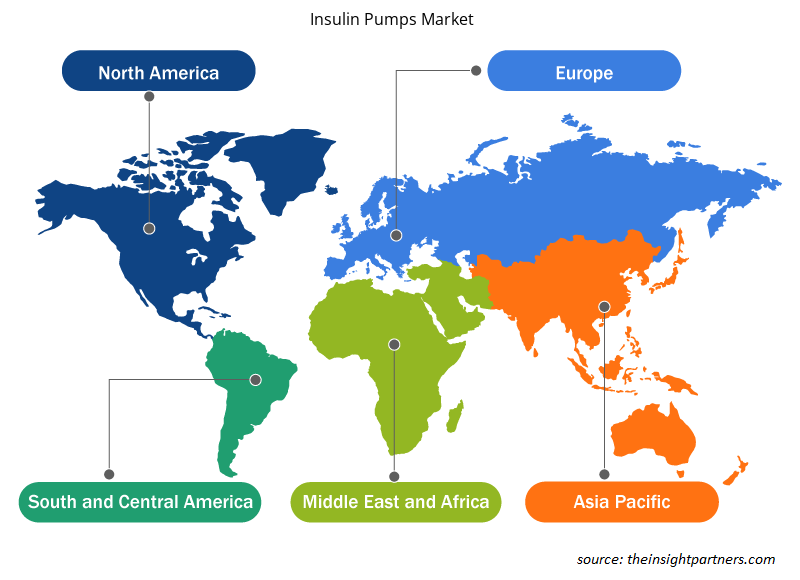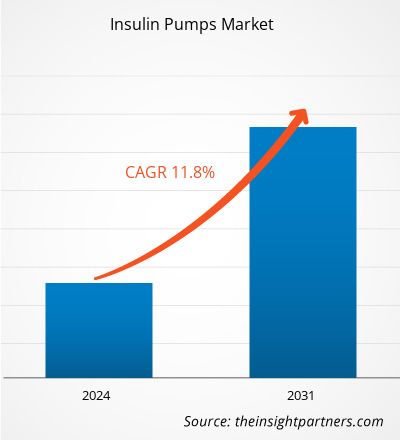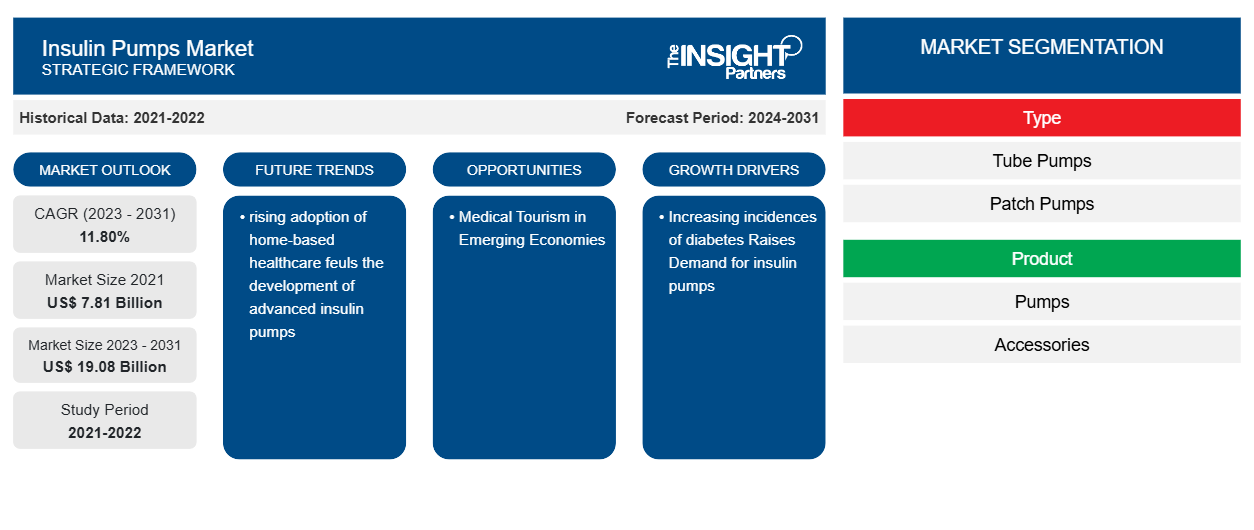El mercado de bombas de insulina se valoró en 7.810 millones de dólares estadounidenses en 2021 y se espera que alcance los 19.080 millones de dólares estadounidenses en 2031. Se espera que el mercado registre una CAGR del 11,80 % entre 2023 y 2031. Es probable que el avance tecnológico siga siendo una tendencia clave en el mercado de bombas de insulina.
Análisis del mercado de bombas de insulina
Las bombas de insulina administran insulina, una hormona que ayuda a reducir los niveles de azúcar en sangre en pacientes con diabetes. La terapia con insulina es un tratamiento esencial para pacientes con diabetes tipo 1 y tipo 2. La diabetes es uno de los problemas de salud más importantes cuya prevalencia está aumentando rápidamente. Por lo tanto, existe la necesidad de un diagnóstico y un tratamiento tempranos de la enfermedad para evitar problemas posteriores, como enfermedades cardíacas. La creciente incidencia y prevalencia de la diabetes y los factores de riesgo asociados, incluidos los cambios en el estilo de vida, la obesidad y el envejecimiento de la población, impulsan la demanda de bombas de insulina en el mercado.
Descripción general del mercado de bombas de insulina
Las innovaciones tecnológicas y las soluciones inteligentes continúan influyendo significativamente en el mercado de las bombas de insulina.
Asia Pacífico es el mercado regional de mayor crecimiento para las bombas de insulina. El mercado en esta región está segmentado en China, Japón, Corea del Sur, India, Australia y el resto de APAC. Se espera que la creciente prevalencia mundial de diabetes, la creciente incidencia de trastornos relacionados con el estilo de vida y el envejecimiento de la población impulsen el crecimiento del mercado en los próximos años. Las bombas de insulina están indicadas para la población de pacientes diabéticos , ya que imitan la función de un páncreas normal al administrar una dosis basal de insulina y dosis en bolo cuando los niveles de glucosa en sangre superan el rango normal. Se espera que la creciente prevalencia afecte significativamente el crecimiento del mercado durante el período de pronóstico. Además, se espera que una sólida cartera de productos y la futura comercialización de bombas de insulina brinden una oportunidad de crecimiento futuro para este mercado.
Personalice este informe según sus necesidades
Obtendrá personalización en cualquier informe, sin cargo, incluidas partes de este informe o análisis a nivel de país, paquete de datos de Excel, así como también grandes ofertas y descuentos para empresas emergentes y universidades.
-
Obtenga las principales tendencias clave del mercado de este informe.Esta muestra GRATUITA incluirá análisis de datos, desde tendencias del mercado hasta estimaciones y pronósticos.
Impulsores y oportunidades del mercado de bombas de insulina
La creciente prevalencia de la diabetes favorece al mercado
Como se destacó en el informe de la Asociación Estadounidense de Diabetes publicado en 2024, 38,4 millones de estadounidenses tenían diabetes en 2021. De ellos, 29,7 millones fueron diagnosticados y 8,7 millones no fueron diagnosticados. Además, el informe de la Federación Internacional de Diabetes publicado en 2022 reveló que América del Norte y el Caribe representaron 51 millones, Europa representó 61 millones, Oriente Medio y África del Norte reportaron 73 millones, África 24 millones, el Sudeste Asiático 90 millones, el Pacífico Occidental 206 millones y América del Sur y Central representaron 32 millones de casos de diabetes en 2021.
Por lo tanto, la creciente prevalencia de la diabetes y los crecientes avances tecnológicos en los dispositivos de administración impulsan el crecimiento de las bombas de insulina.
El turismo médico en auge: una oportunidad
Los avances tecnológicos en el cuidado de la salud en los países en desarrollo están atrayendo a los pacientes a viajar para recibir tratamientos mejores y más rentables y a los principales actores a expandir sus negocios. La mayoría de los fabricantes de bombas de insulina se centran en los mercados emergentes como India, Brasil, Argentina y países de América Latina debido al aumento en la prevalencia de la diabetes y la creciente utilización de dispositivos en la región. En India, la ciencia médica ha proliferado en las últimas décadas. El tratamiento de la diabetes es rentable y está fácilmente disponible en el mercado emergente y la gente de otros países viaja para recibir tratamiento. La razón más posible podría ser los gastos de atención médica excesivamente altos de su país. Debido a los tipos de cambio existentes y otros factores, el tratamiento para la diabetes en India se ha vuelto asequible en comparación con otros países extranjeros. Por lo tanto, se anticipa que el aumento del turismo médico en naciones emergentes como India brindará oportunidades significativas a los actores que operan en el mercado de bombas de insulina durante el período de pronóstico.
Informe de mercado de bombas de insulina Análisis de segmentación
Los segmentos clave que contribuyeron a la derivación del análisis del mercado de bombas de insulina son el tipo,
producto y aplicación.
- Según el tipo, el mercado de bombas de insulina se divide en bombas de tubo y bombas de parche. El segmento de productos desechables podría tener una mayor participación de mercado en 2023.
- En cuanto al producto, el mercado de bombas de insulina está dividido en bombas y accesorios. El segmento de bombas podría tener una mayor participación de mercado en 2023.
- Según la aplicación, el mercado de las bombas de insulina se divide en diabetes tipo I y diabetes tipo II. El segmento de diabetes tipo 1 podría tener una mayor participación de mercado en 2023.
Análisis de la cuota de mercado de las bombas de insulina por geografía
El alcance geográfico del informe del mercado de bombas de insulina se divide principalmente en cinco regiones: América del Norte, Asia Pacífico, Europa, Medio Oriente y África, y América del Sur y Central.
América del Norte ha dominado el mercado de bombas de insulina. Estados Unidos representa una parte considerable del mercado de bombas de insulina en América del Norte. La presencia de los principales proveedores de servicios de atención médica en Estados Unidos es uno de los factores más influyentes responsables del crecimiento del mercado. Se proyecta que Asia Pacífico crecerá con la CAGR más alta en los próximos años.CAGR in the coming years.
Perspectivas regionales del mercado de bombas de insulina
Los analistas de Insight Partners explicaron en detalle las tendencias y los factores regionales que influyen en el mercado de bombas de insulina durante el período de pronóstico. Esta sección también analiza los segmentos y la geografía del mercado de bombas de insulina en América del Norte, Europa, Asia Pacífico, Oriente Medio y África, y América del Sur y Central.

- Obtenga datos regionales específicos para el mercado de bombas de insulina
Alcance del informe de mercado de bombas de insulina
| Atributo del informe | Detalles |
|---|---|
| Tamaño del mercado en 2021 | 7.810 millones de dólares estadounidenses |
| Tamaño del mercado en 2031 | US$ 19.08 mil millones |
| CAGR global (2023 - 2031) | 11,80% |
| Datos históricos | 2021-2022 |
| Período de pronóstico | 2024-2031 |
| Segmentos cubiertos |
Por tipo
|
| Regiones y países cubiertos |
América del norte
|
| Líderes del mercado y perfiles de empresas clave |
|
Densidad de actores del mercado de bombas de insulina: comprensión de su impacto en la dinámica empresarial
El mercado de bombas de insulina está creciendo rápidamente, impulsado por la creciente demanda de los usuarios finales debido a factores como la evolución de las preferencias de los consumidores, los avances tecnológicos y una mayor conciencia de los beneficios del producto. A medida que aumenta la demanda, las empresas amplían sus ofertas, innovan para satisfacer las necesidades de los consumidores y aprovechan las tendencias emergentes, lo que impulsa aún más el crecimiento del mercado.
La densidad de actores del mercado se refiere a la distribución de las empresas o firmas que operan dentro de un mercado o industria en particular. Indica cuántos competidores (actores del mercado) están presentes en un espacio de mercado determinado en relación con su tamaño o valor total de mercado.
Las principales empresas que operan en el mercado de bombas de insulina son:
- Corporación Insulet
- Medtronic
- Cuidado de la diabetes en tándem, Inc.
- Debiotech SA
- CELDA NOVO
- SOOIL Desarrollos Co., Ltd.
Descargo de responsabilidad : Las empresas enumeradas anteriormente no están clasificadas en ningún orden particular.

- Obtenga una descripción general de los principales actores clave del mercado de bombas de insulina
Noticias y desarrollos recientes del mercado de bombas de insulina
El mercado de bombas de insulina se evalúa mediante la recopilación de datos cualitativos y cuantitativos posteriores a la investigación primaria y secundaria, que incluye publicaciones corporativas importantes, datos de asociaciones y bases de datos. A continuación, se incluye una lista de los desarrollos en el mercado de bombas de insulina y las estrategias:
- PharmaSens, con sede en Suiza, solicitó la aprobación de la FDA para su sistema de bomba de parche de insulina 'niia essential'. La empresa también obtuvo la certificación ISO 13485 en noviembre de 2023 para el diseño, desarrollo, fabricación y distribución del sistema. El producto es una bomba de parche de bolo basal con un diseño aerodinámico que combina la facilidad de una pluma de insulina con las ventajas de una bomba de insulina sofisticada. Cuenta con un innovador depósito de 3 ml, lo que la convierte en una de las bombas de parche más compactas del mercado. El sistema de bomba de parche de insulina también incorpora un mecanismo automático de inserción de agujas y un concepto semirreutilizable para lograr una mayor rentabilidad y un diseño de producto sostenible. (Fuente: PharmaSens AG, comunicado de prensa, 2023)
- La Administración de Alimentos y Medicamentos de los Estados Unidos (FDA) aprobó la bomba iLet ACE de Beta Bionics y el software de decisión de dosificación iLet para personas de 6 años o más con diabetes tipo 1. Estos dos dispositivos y un monitor continuo de glucosa integrado (iCGM) compatible aprobado por la FDA forman un nuevo sistema llamado iLet Bionic Pancreas. El nuevo sistema de dosificación automática de insulina (AID) utiliza un algoritmo para determinar y ordenar la administración de insulina. (Fuente: FDA de los Estados Unidos, comunicados de prensa, 2023)
Informe de mercado sobre bombas de insulina: cobertura y resultados
El informe “Tamaño y pronóstico del mercado de bombas de insulina (2021-2031)” proporciona un análisis detallado del mercado que cubre las siguientes áreas:
- Tamaño del mercado y pronóstico a nivel global, regional y nacional para todos los segmentos clave del mercado cubiertos bajo el alcance
- Dinámica del mercado, como impulsores, restricciones y oportunidades clave
- Principales tendencias futuras
- Análisis detallado de las cinco fuerzas de Porter y PEST y FODA
- Análisis del mercado global y regional que cubre las tendencias clave del mercado, los principales actores, las regulaciones y los desarrollos recientes del mercado.
- Análisis del panorama de la industria y de la competencia que abarca la concentración del mercado, el análisis de mapas de calor, los actores destacados y los desarrollos recientes
- Perfiles detallados de empresas
- Análisis histórico (2 años), año base, pronóstico (7 años) con CAGR
- Análisis PEST y FODA
- Tamaño del mercado, valor/volumen: global, regional y nacional
- Industria y panorama competitivo
- Conjunto de datos de Excel
Informes recientes
Informes relacionados
Testimonios
Razón para comprar
- Toma de decisiones informada
- Comprensión de la dinámica del mercado
- Análisis competitivo
- Información sobre clientes
- Pronósticos del mercado
- Mitigación de riesgos
- Planificación estratégica
- Justificación de la inversión
- Identificación de mercados emergentes
- Mejora de las estrategias de marketing
- Impulso de la eficiencia operativa
- Alineación con las tendencias regulatorias























 Obtenga una muestra gratuita para - Mercado de bombas de insulina
Obtenga una muestra gratuita para - Mercado de bombas de insulina